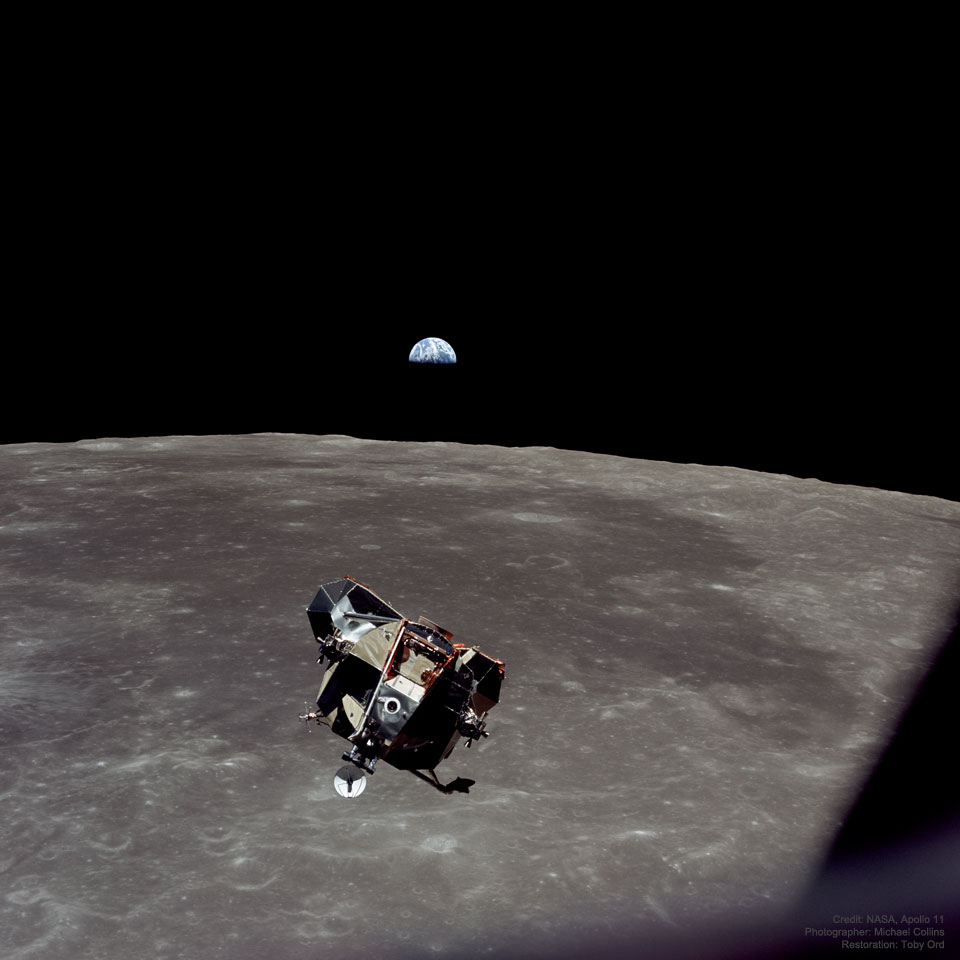03. May 2021
阿波羅 11 號:地球、月球、太空船

探索宇宙1!逐工會揀一幅無仝款 ê 影像抑是相片,𤆬你熟似咱這个迷人 ê 宇宙,閣有專業天文學者2為你3解說4。
- 原始文章:Apollo 11: Earth, Moon, Spaceship
- 影像來源:NASA, Apollo 11
- 影像修復:Toby Ord
- 台文翻譯:An-Li Tsai (NCU)
- NASA Remembers Michael Collins
[漢羅] 阿波羅 11 號:地球、月球、太空船
Tī 現代歷史上有名 ê 太空旅行行煞了後,差不多 to̍h 是應該愛轉來 ê 時陣矣。 Tī 證明 人類 有才調超越 地球 ê 束縛了後,第一个 tī 地球以外 ê 世界行踏 ê 人類是 Neil Armstrong kah Buzz Aldrin。 In kā 登月艙 飛轉來到踅月 ê 指揮服務艙 kah Michael Collins 會合。 這張相片 是 tī 1969 年 7 月 21 翕,最近才 數位修復 ê。 太空船升空 ê 模樣 去予 Collins 翕著,下跤有月球,遠方有地球。 Tī 月球面頂這个金滑 koh 烏暗 ê 所在是 Mare Smythii,to̍h tī 月球倚地球這爿上東爿邊仔 ê 赤道下跤。 Tī 這張代表性 ê 相片,逐家攏 tī lih,干焦一个無 tī 鏡頭頭前。
[POJ] A-pho-lô cha̍p-it hō: Tē-kiû, Goe̍h-kiû, Thài-khong-chûn
Tī hiān-tāi le̍k-sú-siōng ū-miâ ê thài-khong-lú-hêng kiâⁿ-soah liáu-āu, chha-put-to to̍h sī eng-kai ài tńg--lâi ê sî-chūn ah. Tī chèng-bêng jîn-lūi chiah ū châi-tiāu chhiau-oa̍t Tē-kiû ê sok-pa̍k liáu-āu, tē-it-ê tī Tē-kiû ì-gōa ê sè-kài kiâⁿ-ta̍h ê jîn-lūi sī Neil Armstrong kah Buzz Aldrin. In kā Teng-goe̍h-chhong poe tńg-lâi kàu se̍h-goe̍h ê Chí-hui Ho̍k-bū-chhong kah Michael Collins hōe-ha̍p. Chit-tiuⁿ siòng-phìⁿ 是 tī i̍t-kiú-lio̍k-kiú nî chhit goe̍h jī-it hip, chòe-kīn chiah só͘-ūi siu-ho̍k ê. Thài-khong-chûn seng-khong ê bô͘-iūⁿ khì hō͘ Collins hip-tio̍h, ē-kha ū Goe̍h-kiû, oán-hong ū Tē-kiû. Tī Goe̍h-kiû bīn-téng chit-ê kng-ku̍t koh o͘-àm ê só͘-chāi sī Mare Smythii,to̍h tī Goe̍h-kiû óa Tē-kiû chit-pêng siōng tang-pêng piⁿ-á ê chhek-tō ē-kha. Tī chit-tiuⁿ tāi-piáu-sèng ê siòng-phìⁿ, ta̍k-ke lóng tī lih, kan-na chi̍t-ê bô tī kiàⁿ-thâu thâu-chêng.
[KIP] A-pho-lô tsa̍p-it hō: Tē-kiû, Gue̍h-kiû, Thài-khong-tsûn
Tī hiān-tāi li̍k-sú-siōng ū-miâ ê thài-khong-lú-hîng kiânn-suah liáu-āu, tsha-put-to to̍h sī ing-kai ài tńg--lâi ê sî-tsūn ah. Tī tsìng-bîng jîn-luī tsiah ū tsâi-tiāu tshiau-ua̍t Tē-kiû ê sok-pa̍k liáu-āu, tē-it-ê tī Tē-kiû ì-guā ê sè-kài kiânn-ta̍h ê jîn-luī sī Neil Armstrong kah Buzz Aldrin. In kā Ting-gue̍h-tshong pue tńg-lâi kàu se̍h-gue̍h ê Tsí-hui Ho̍k-bū-tshong kah Mitsael Collins huē-ha̍p. Tsit-tiunn siòng-phìnn 是 tī i̍t-kiú-lio̍k-kiú nî tshit gue̍h jī-it hip, tsuè-kīn tsiah sóo-uī siu-ho̍k ê. Thài-khong-tsûn sing-khong ê bôo-iūnn khì hōo Collins hip-tio̍h, ē-kha ū Gue̍h-kiû, uán-hong ū Tē-kiû. Tī Gue̍h-kiû bīn-tíng tsit-ê kng-ku̍t koh oo-àm ê sóo-tsāi sī Mare Smythii,to̍h tī Gue̍h-kiû uá Tē-kîu tsit-pîng siōng tang-pîng pinn-á ê tshik-tō ē-kha. Tī tsit-tiunn tāi-piáu-sìng ê siòng-phìnn, ta̍k-ke lóng tī lih, kan-na tsi̍t-ê bô tī kiànn-thâu thâu-tsîng.
[English] Apollo 11: Earth, Moon, Spaceship
After the most famous voyage of modern times, it was time to go home. After proving that humanity has the ability to go beyond the confines of planet Earth, the first humans to walk on another world -- Neil Armstrong and Buzz Aldrin -- flew the ascent stage of their Lunar Module back to meet Michael Collins in the moon-orbiting Command and Service Module. Pictured here on 1969 July 21 and recently digitally restored, the ascending spaceship was captured by Collins making its approach, with the Moon below, and Earth far in the distance. The smooth, dark area on the lunar surface is Mare Smythii located just below the equator on the extreme eastern edge of the Moon's near side. It is said of this iconic image that every person but one was in front of the camera.
詞彙學習
| 漢羅 | POJ | KIP | 華語 | English |
|---|---|---|---|---|
| 阿波羅 11 號 | A-pho-lô cha̍p-it hō | A-pho-lô tsa̍p-it hō | 阿波羅 11 號 | Apollo 11 |
| 登月艙 | Teng-goe̍h-chhong | Ting-gue̍h-tshong | 登月艙 | Apollo 11 |
| 指揮服務艙 | Chí-hui Ho̍k-bū-chhong | Tsí-hui Ho̍k-bū-tshong | 指揮服務艙 | Command and Service Module |
| 赤道 | chhek-tō | tshik-tō | 赤道 | equator |